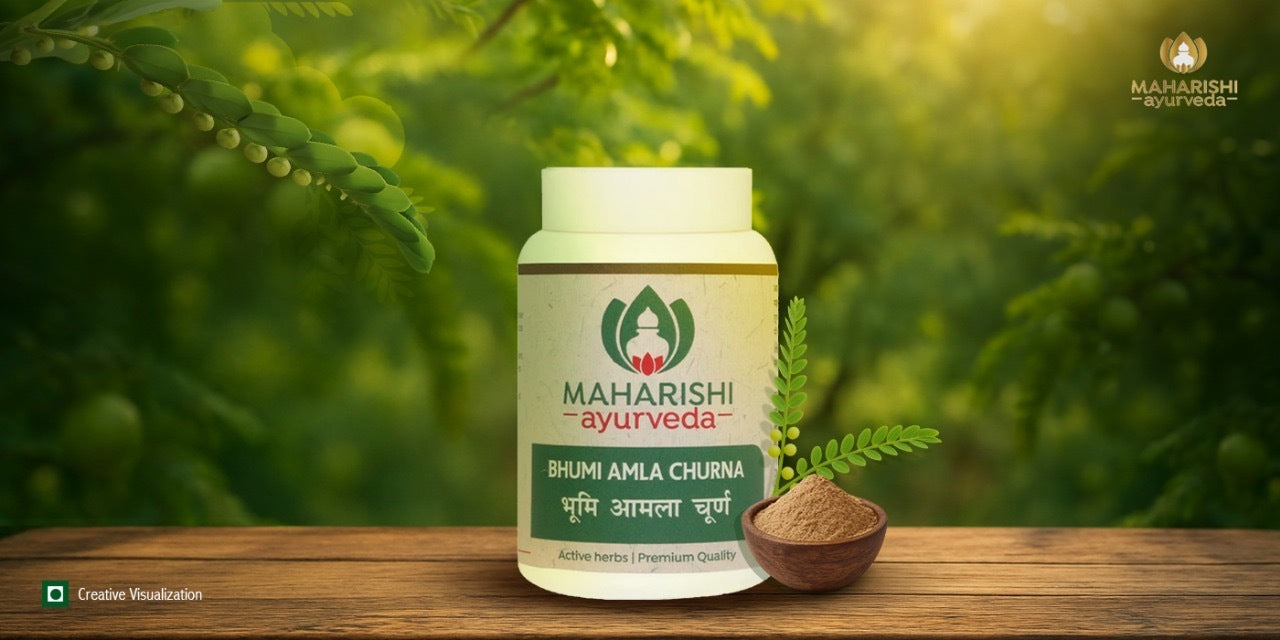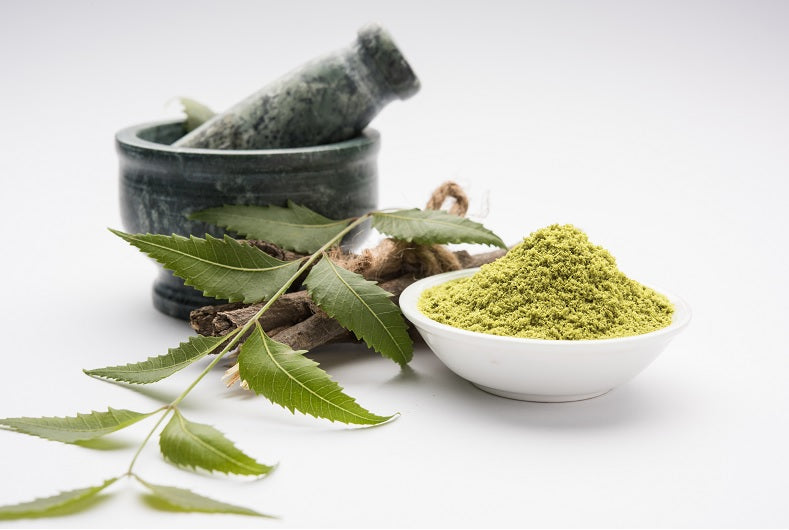
Bhumi Amla – Ayurvedic Herb for Liver Health, Digestion & Immunity
29 Jul, 2025Introduction to Bhumi Amla Imagine walking through a quiet forest after fresh monsoon showers,...
Read more
Imagine walking through a quiet forest after fresh monsoon showers, where the ground flourishes with tiny green herbs. Among these treasures lies Bhumi Amla, known to traditional vaidyas for centuries as the silent healer of liver ailments and digestive struggles. While many today chase quick detox pills or restrictive diets to relieve their digestive or liver woes, Ayurveda offers an age-old ally growing humbly at our feet.
This powerful herb, often overshadowed by its taller namesake amla tree, carries within it potent cleansing, rejuvenating, and protective properties that modern science is only beginning to understand. In this article, we delve deep into Bhumi Amla’s botanical identity, nutritional richness, health benefits, traditional usage, and safety guidelines to help you decide if it deserves a place in your daily wellness routine.
Botanical Name: Phyllanthus Niruri
Family: Euphorbiaceae
It is familiar by various local names in India:
Tamil: Keezhanelli
Telugu: Nela Us
Hindi: Bhumi A
Kannada: Bhumi Nelli
Its synonyms are Bhumyamalaki, Bhudhatri, Tamalaki, Bahupatra, and Bahuphala, which all indicate its various
In classical texts, Bhumi Amla is revered as Bhumyamalaki. It is classified as an herb that pacifies Pitta and Kapha doshas, while potentially aggravating Vata if used in excess due to its cooling and drying properties. Its traditional use spans liver rejuvenation, digestive strengthening, and cleansing therapies, earning it names like Tali for waste removal and Sookshmapatri, referring to its delicate, small leaves.
It is a perennial herb, attaining a height of 18–24 cm, with tiny leaflets lining slender stems. Its small fruits are similar to tiny amlas, receiving the name “ground amla”.
Where It Is Found in India
It grows well in Central and Southern India, and does well in dark, wet places, particularly during the rainy months. You are likely to find it plentifully in paddies, forest margins, and trails after the summer showers.
How to Identify the Plant
Look for a short herb with small leaves arranged neatly along thin stems, bearing tiny greenish fruits underneath the leaves. Its fruits are the easiest identifier as they resemble Amla but grow directly under the leaf stalks.

While often confused with the amla tree (Emblica officinalis) due to similar fruit appearance, Bhumi Amla is a small herb, whereas Amla is a large tree with bigger edible fruits. Bhumi Amla remains ground-dwelling and delicate, whereas Amla bears its fruits on branches.
Bhumi Amla is rich in bitter (Tikta), astringent (Kashaya), and sweet (Madhura) tastes, and is light (Laghu) and dry (Ruksha) in quality with cold potency (Sheeta). Its actions span hepatoprotective, antioxidant, digestive stimulant, diuretic, and anti-inflammatory effects, supporting plasma, blood, fat, and female reproductive tissues.

The foremost benefit of Bhumi Amla lies in its ability to protect and rejuvenate the liver. It is traditionally used in jaundice, hepatitis B, fatty liver, and hepatosplenomegaly. Its hepatoprotective and bile-enhancing properties aid in detoxifying liver toxins, as supported by modern studies highlighting the presence of phyllanthin and hypophyllanthin as protective compounds.
Check Now: 10 Silent Signs Your Liver Might Be in Trouble—>
It serves as a deepana (appetiser), pachana (digestive), and anulomana (carminative) drug. It increases the digestive fire, alleviates hyperacidity, dyspepsia, diarrhoea, and dysentery, and regulates
Its hypoglycaemic and diuretic properties make it supportive in blood sugar regulation, beneficial for individuals managing diabetes alongside their practitioner’s guidance.
Due to its antioxidant and cooling nature, Bhumi Amla decreases the inflammation for conditions like arthritis or fractures, whereas it increases the immune response when fighting infections.
By cleansing the Blood and Lowering Toxicity, it Treats Skin Disorders such as Eczema, Dermatitis, Ulcers, and Wounds, Imparting Better-looking and Healthier-Feeling Skin.
Also referred to as a stonebreaker herb, it helps break down tiny kidney stones, inhibits their formation, and promotes general urine health because of its diuretic properties.
It has been demonstrated to exhibit activity against hepatitis B, enteroviruses, and urinary/respiratory pathogens, thus substantiating the use as revealed by ethnomedical studies for the treatment of viral/microbial infections.
It is Kasahara (anti-cough) and Shwashara (beneficial for breathing issues), making it effective in managing coughs, chronic fevers, and respiratory infections.
Traditional Practice in Ayurveda
It comes in use, internally, in powders, juices, decoctions, and infusions, for liver, digestive, urinary, and gynaecological disorders. Externally, the paste of the drug is applied over wounds, inflammation, fractures, and diseases of the skin.
Available Forms
How to Make Bhumi Amla Juice at Home
In fatty liver, Bhumi Amla powder (3–6 gms) or fresh juice (10–20 ml) may be taken two times daily. Decoction (10–20 ml) is also helpful for purification. Always consult an Ayurvedic practitioner for the correct dosage.
Morning consumption aids in detoxification and digestion, while evening use supports liver purification at night. Modify with the help of a professional.
Powder: 3–6 gms daily
Juice: 10–20 ml daily
Lower dosage as advised by an Ayurvedic doctor
Morning intake enhances digestion and detox, while night intake supports liver rejuvenation. Select timing based on health goals and practitioner advice.
Always seek expert advice before starting treatment for chronic diseases, during pregnancy, or when taking other medications to prevent herb-drug interactions.
Results depend upon the severity of the condition. Digestive and liver benefits are commonly evident 1–3 weeks after regular use with an appropriate diet and lifestyle.
May interact with diabetes medications, diuretics. Consult a Vaidya before taking together.
Approved only under the practitioner's direction because of its strong ability to detoxify.
Avoid excessive dosage to avert possible Vata imbalance or gastrointestinal distress. Consume sustainably according to expert counsel.
Bhumi Amla stands as an ancient herb offering liver protection, digestive strengthening, blood sugar regulation, immune boosting, and skin purification in one humble plant. If you seek natural solutions for liver detox or digestive enhancement, Bhumi Amla is worth considering. When selecting Bhumi Amla, it is essential to choose a formulation that retains its purity and traditional potency. Maharishi Ayurveda’s Bhumi Amla product is prepared with this classical wisdom, ensuring that each serving delivers the authentic benefits described in Ayurveda texts. Whether you choose its powder, tablet, or syrup form, incorporating Maharishi Ayurveda Bhumi Amla mindfully under practitioner guidance could be your step towards holistic health and balanced living.
Embrace Holistic Healing – Shop Bhumi Amla Churna Now!
Yes. Hepatoprotective activity treats fatty liver through the enhancement of liver detox and bile excretion.
Bhumi Amla powder or juice is traditionally used for fatty liver. Consult your practitioner for dosage.
It helps to regulate blood sugar as it has a hypoglycaemic effect.
Results differ; benefits to the liver and digestion can result within 1–3 weeks.
Yes, in doses recommended. Avoid excessive use to prevent Vata aggravation.
Search for a small terrestrial herb (18–24 cm high) with tiny amla-like fruits forming under the leaves.
Introduction to Bhumi Amla Imagine walking through a quiet forest after fresh monsoon showers,...
Read more Guide to Immunity
Guide to Immunity
 Featured Articles
Featured Articles

Are you struggling with your oral health because of your eating habits? Are toothaches becoming your new normal because you have not been brushing well? Is eating ice cream a big NO, as you have brushed a little too much? A lot of you have been made to believe that your oral issues emanate from what you are doing wrong or not doing the right thing. What if we tell you that you have been approaching this all wrong and trying to solve the problems topically instead of addressing the root cause? Do you ever think about the real reason for these significant dental issues?
Ayurveda helps you focus on the fundamentals and identify the root cause. It is the science of treating the underlying imbalances and correcting the cause in a completely natural and effective way. Among its numerous health benefits, when it comes to oral health, Ayurvedic Toothpaste is a game-changer for preserving strong and healthy teeth. A natural and effective alternative to the chemical-laden equivalents and a beneficial synergy of herbs that help in holistic dental care. Surprising, right!? Well, read on to turn your surprise into a new belief!


नित्यमध्मान तां तांस्तु व्याधिभिश्च विवर्जितः।
रसैश्च दन्तमूलानां रूक्षैराचाम्य विक्रियाम्॥
Meaning: Regularly cleaning your mouth makes your teeth and gums healthy and prevents diseases.
The Charaka Samhita mentions the importance of oral care in overall health. This is more than just information from ancient scriptures; much research has validated the role of a healthy mouth in a healthy body. A 2022 study in Frontiers of Microbiology highlighted this critical link: an imbalance in the oral microbiome causes periodontal disease and promotes cardiovascular disease development.
Wondering how? Saliva is the first fluid that is secreted during digestion. It lubricates the tongue and oral cavity and ensures that the whole digestive tract stays lubricated, along with the chewed food passed down to the stomach. It carries all microbes into your gut and is the most crucial link between oral and overall health
Saliva also contains some antimicrobial proteins and enzymes that keep harmful microorganisms from growing while ensuring the good ones thrive. However, any saliva production or composition imbalance can affect the oral microbiota. This could be due to poor oral hygiene, an unhealthy diet, or systemic health issues.
This imbalance can have dire consequences for oral health, such as dental caries, gum issues, and infections. Moreover, balanced saliva helps lubricate and break down food for easy digestion and ensures that teeth get essential minerals to maintain and repair themselves.

Dantadhaawan is an ancient Ayurvedic oral hygiene practice that involves using herbal twigs, AKA ‘‘Datoon’’, to clean teeth and gums. Commonly used twigs include those from the neem, babool, and liquorice plants. These twigs have antimicrobial properties that help maintain oral hygiene.
According to the Shadrasa (six tastes) in Ayurveda, every herb has a Rasa (dominant taste) that determines its properties and actions.
An ideal toothpaste must contain Katu, Tikta, Kashaya, and Madhura Rasa, each of which positively impacts maintaining the health of our oral cavity.
Let’s uncover the properties of these essential Rasas to know more:
|
Rasa |
Action |
|
Katu (Pungent) |
It deeply cleanses the oral cavity |
|
Tikta (Bitter) |
Antibacterial & antiseptic action |
|
Kashaya (Astringent) |
Provides pain relief |
|
Madhura (Sweet) |
Strengthens the gums & teeth |
You see, an Ayurvedic toothpaste not only cleanses your teeth but also gives Bala (strength) through the properties of the natural Dravyas (herbs) used in it.

It may sound complex, but formulating toothpaste at home is as easy as making a face pack! All you need is 10 grams of dry leaves or powders of neem, mulethi, jamun, and amalaki. Grind or mix them, and your dry toothpaste powder is ready! During every brushing session (preferably morning and evening), mix it with your *Dosha-appropriate adjuvants. Vata *Dosha* can mix sesame oil, Pitta *Dosha* can mix ghee, and Kapha *Dosha* can mix honey/mustard oil, and your quick, healthy toothpaste is ready!
If you’re a busy bee, not interested in DIYs, or find it difficult to source these ingredients, don’t worry! We have Maharishi Ayurveda Ayurdent Toothpaste. It is your one-stop solution to all your oral problems. It’s a unique formulation that works on your saliva and is suitable for all body types, irrespective of the Doshic predominance.
It contains neem for cleansing, triphala for balancing, and meswak & ginger for stimulating saliva. Ayurdent promotes holistic oral health naturally and provides protection from major oral problems like cavities, plaque, bleeding gums, toothache, sensitivity, and bad breath. It contains the goodness of 20 Ayurvedic ingredients and is free from SLS and fluoride. Certified by COSMOS Natural, it stands out for its authenticity compared to other Ayurvedic and herbal toothpaste. This innovative, non-foaming formula is a must-try in the category.
 Vaidya Recommended
Vaidya Recommended

As per Ayurveda, no two individuals are alike. Maharishi Ayurveda offers personalised treatment for each individual at all touch-points. Consult our expert Vaidyas to get root cause-based personalised treatment from the comfort of your home
CONSULT VAIDYA